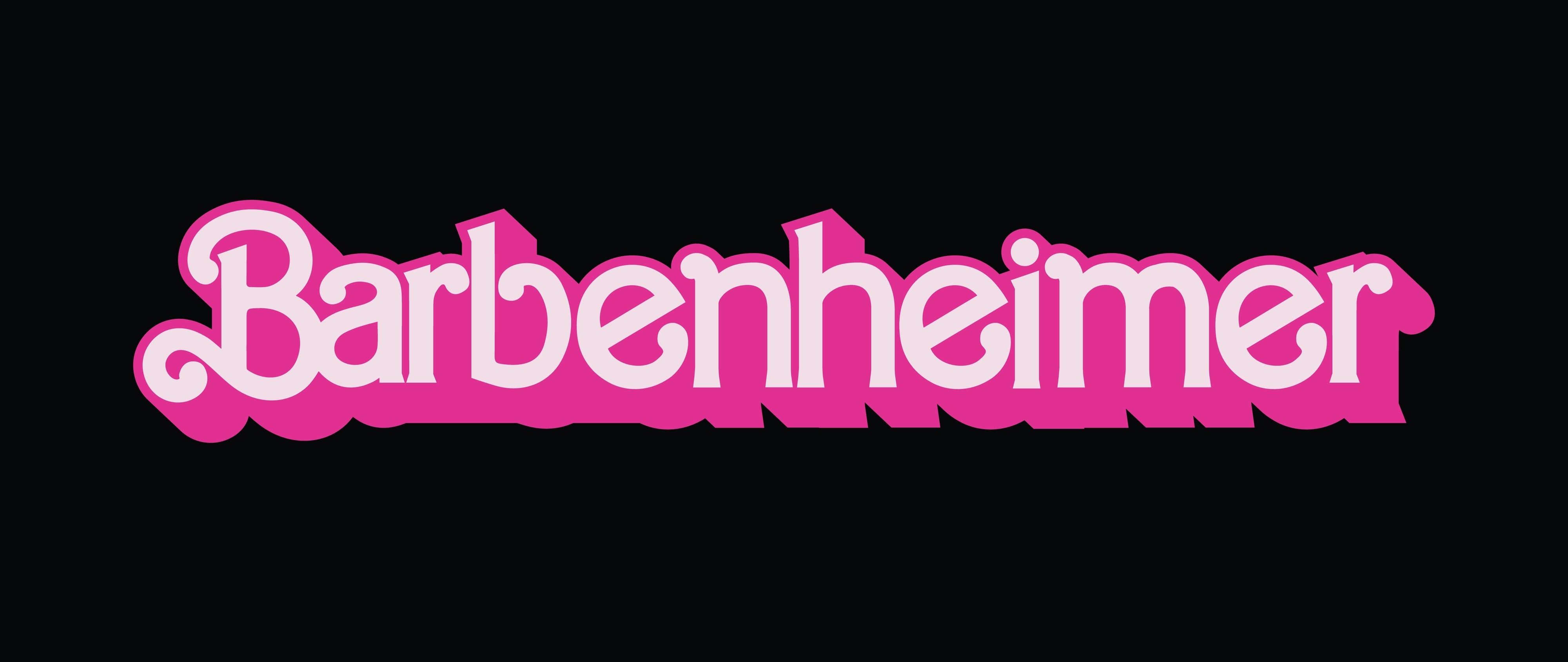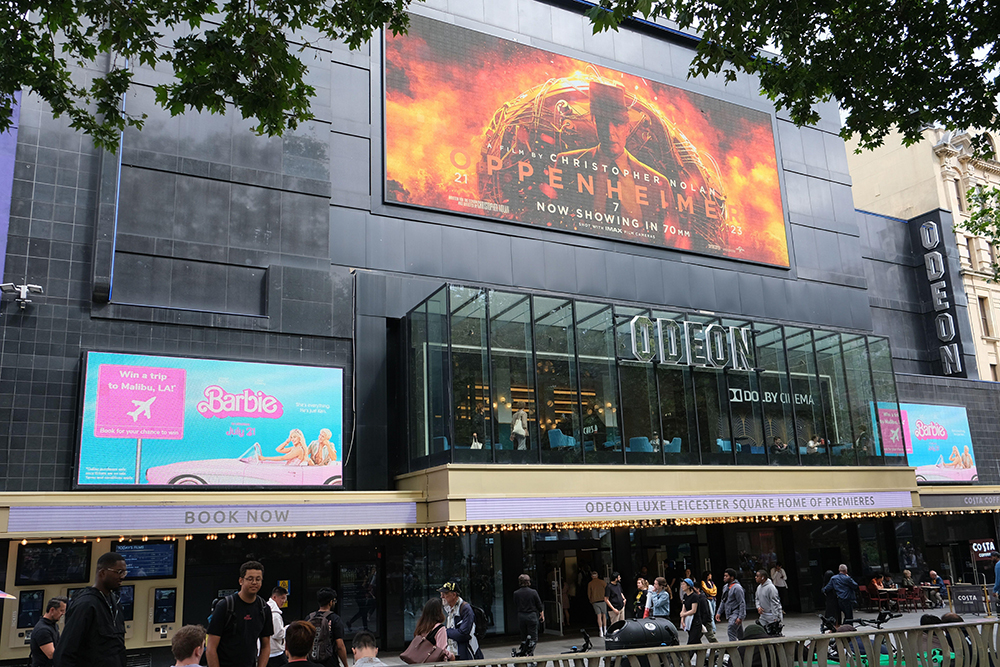It’s been impossible to miss the much-hyped ‘Barbenheimer’ phenomenon this summer. A portmanteau of Barbie (Greta Gerwig, 2023) and Oppenheimer (Christopher Nolan, 2023), the word was coined by film fans on social media following studio announcements that the two different genre movies would release in cinemas on the same day.
It’s not the first time that two different genre films have opened the same weekend in the summer. For instance, in 2008 another Nolan film, Batman thriller The Dark Knight, appeared in cinemas on the same day as ABBA musical Mamma Mia! (Phyllida Lloyd). However, Barbenheimer has captured public imagination in a big way.
On platforms such as Twitter and Instagram, people have created visual jokes riffing on the contrasting aesthetics of Barbie’s bubblegum pink and Oppenheimer’s moody black. There have been numerous memes that play on the films’ up versus downbeat themes. And many brands – especially in the worlds of fashion and beauty – have made canny use of Barbenheimer in their advertising campaigns.
HAPPY BARBENHEIMER RELEASE WEEK pic.twitter.com/9rMbMPvr62
— Film Updates (@FilmUpdates) July 17, 2023
For the studios behind the films (Warner Bros. and Universal respectively), the hype has paid off. Opening weekend box office returns were the fourth highest on record, with Barbie taking $155 million and Oppenheimer $80 million. On 6 August 2023, Gerwig became the first woman to make over a billion dollars globally in cinemas as a solo director.
Given that box office takings have declined by 50% over the past four years – likely owing to factors including home streaming services, pandemic cinema closures, and rising living costs – it’s easy to understand why some commentators think that Barbenheimer signals a reverse in fortune for theatrical screenings.
But can Barbenheimer save cinema? What kind of cinema are we talking about saving? And does it really need saving at all?
 Barbenheimer text in a pink Barbie-branded typeface.
Barbenheimer text in a pink Barbie-branded typeface.
It’s important to note that most analysts believe Barbenheimer has saved 2023’s summer box office and are not making any broad claims about the future. It’s wise to be cautious because grand narratives about films ‘saving’ cinema have abounded in recent years, with examples including Top Gun: Maverick (Joseph Koninski, 2022) and Avatar: The Way of Water (James Cameron, 2022). What saviour movies tend to have in common is their mainstream, blockbuster status; these are films with well-known directors, recognisable stars, multi-million dollar studio marketing campaigns, and often franchise affiliation.
Where Barbie (albeit based on a toy) and Oppenheimer differ is in the originality of their stories and themes. Both are directed by filmmakers who started out making indie, or arthouse, pictures. It’s notable that audiences for both releases are invited to engage on intellectual and emotional levels with questions about power, identity and responsibility (while Barbie is a musical comedy, it does not shy away from critiquing gender dynamics). People may relish the opportunity to dress up and see the two contrasting films as a double bill as a bit of fun. The Barbenheimer phenomenon suggests that audiences also want to be challenged.
But we should be wary about focusing too intently on Hollywood when we talk about global cinema, for India (Bollywood) and Nigeria (Nollywood) among others, have economically successful film industries that are not always subject to the same problems. At the very least, we need to question whether we mean that all cinema needs saving.
 Margot Robbie as Barbie.
Margot Robbie as Barbie.
Moreover, it’s crucial that we look beyond blockbuster releases to the health of arthouse cinema. The system that many film distributors insist that exhibitors subscribe to – whereby studios demand cinemas give over a percentage of their screens to a film and show it repeatedly in order to secure a booking – can be detrimental to smaller indie movies. This can make it harder for them to attract an audience and recover filmmaking costs via ticket sales, which can affect a director’s chance of securing funding to develop new projects in future.
With writers and actors on strike in Hollywood – the WGA and SAG-AFTRA unions are taking action against studios including Disney and Netflix over pay, conditions and the use of AI – even the future of blockbuster filmmaking looks uncertain. With studio management teams taking home huge salaries and some creative talent unable to afford healthcare, the Hollywood screen industry faces challenges that run deeper than audience numbers.
As people’s engagement with film continues to change in the wake of technological advances (such as online streaming and VR), the nearly 130-year-old tradition of cinema going may continue to decline in popularity. Or perhaps, in an era in which our need for human contact is being re-evaluated, communal viewing experiences will become the norm again. Although Barbenheimer’s success is an exciting moment in cultural history, it’s unclear as yet what longer-term part it might play in any trends beyond pink and black fashions.
Crucially, if Hollywood and other national cinema industries are going to be ‘saved’, funders need to invest in creative talent and original ideas to attract audiences. It’s only when staff and audience needs are properly recognised that cinema can truly be saved.




Rate and Review
Rate this article
Review this article
Log into OpenLearn to leave reviews and join in the conversation.
Article reviews